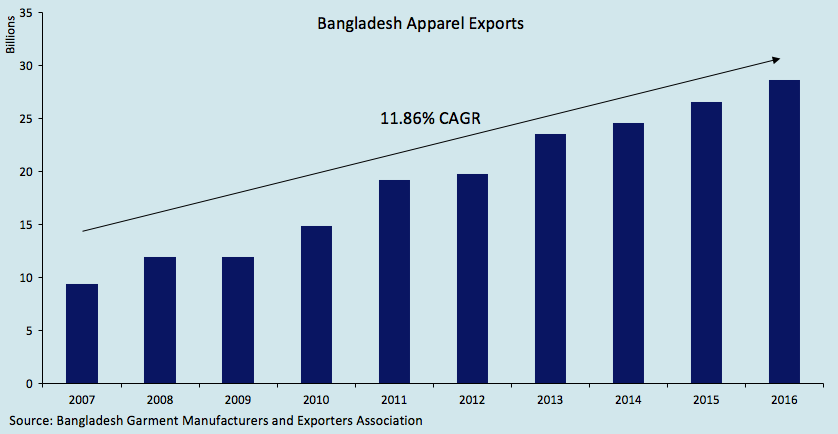Textiles in Bangladesh - Economy
Primary Contributor: Suyeon Han
According to The International Monetary Fund (IMF), the Bangladesh economy is globally the second fastest growing economy with a 7.1% increase in GDP in 2016. Since 2004, economic development remains relatively robust in Bangladesh compared to the rest of the world, with the GDP growth averaging 6.5%. It is important to note the driving force behind this impressive performance is the textiles industry, broadly consisting of textiles, clothing, and ready-made garments (RMG). The industry contributes 228.4 billion, or 28.1% of total GDP, and RMG holds the largest market share among textiles.
Currently, Bangladesh enjoys competitive advantage in being able to provide access to its large labour market. However, fragile political conditions, as well as possible mobilization of activist groups for workers’ rights may pose impediments to prospective profits. Examples of such incidents include the blockade of transportation by the political opposition in early 2015, and the crippling strike in July-December period of 2016, where the latter caused the export earnings of woven garments to decline by 9.36%. Due to the death of thousands of workers in factory fire incidents, there has been an international demand to improve the labour conditions in the Bangladeshi textile industry. Thus, brewing uncertainty in an already-fragile economic environment. The potential interference to business practices of these events, resulting in missed-time and missing production targets, poses risks for both the country and the investors.
To mitigate prospective damages, corporations and government should improve workers’ rights and invest in workplace infrastructures to implement minimum safety standards. Improving workers right can be carried out in many ways, an important first step in this is granting workers the right to form trade unions. Trade unions give the workers a right to speak and change the current poor working conditions without fearing job security. The base document for workers’ rights in Bangladesh is the Bangladesh Labour Act 2006 which was amended in 2013 after Bangladesh’s most devastating incident Rana Plaza. The amendments did make it easier to form unions, however Human Rights Watch reports that in actuality, nothing has changed. This is why is takes both the government making legislative changes and the factory managers and ultimately the corporations employing them, to implement the change. In addition other changes regarding workers’ rights must be made to bring Bangladesh up to international standards, such as remunerations, prohibition of debt bondage and discrimination, or allowance of workers strikes. Investors look not only at the cost of production, but also the effects on brand image of said production method. Legislation of labour laws will increase the cost of manufacturing, and, thus, result in either high prices for the consumers, or lower profit margin for the companies. Hence, to protect the interests of both businesses and their employees in Bangladesh, investors should negotiate with the government for realistic labour laws that would not stunt Bangladesh’s economic development.

As can be seen on the graph, despite the civil unrest and the potential negative impacts associated, the garment industry has sustained consistent development over the past decade. This is demonstrated with the industries CAGR of 11.86%. Although growth has slowed down in the past five years, with an average of 8.47% growth, the sector still indicates strong potential.
According to the Bangladesh Bank, overall rate of inflation increased from 5.53% in September 2016 to 6.12% in September 2017, as measured by CPI with the base year set as 2005-to-2006-year prices. As according to an article from the World Bank in 2016, suppressed domestic demand, the increase in wages, electricity, and gas prices are main contributors to the increase. As well, the decline in private investment rate from 1.5% contribution to GDP to 1.3% creates a concern as it signals shared sense of uncertainty among the investors. Hence, despite the large potential for growth, the lack of infrastructures to generate stability in Bangladesh economy pose risks.
Concluding, the positive empirical data reflects the extent to which Bangladesh’s economy relies on the textile industry. Unstable political environment and slow economic reform are the main threats to prospective investors for the textiles industry in Bangladesh. To ensure the longevity of the current rapid economic expansion, it is necessary for the government to continue to invest in stable macroeconomic growth. Falling interest rates, steady inflation, an increase in reserves, and infrastructure investment like energy and transportation are essential to stabilize the economy. The challenge for the Bangladesh economy is to establish a clear agenda for development to achieve sustainable and inclusive growth.







